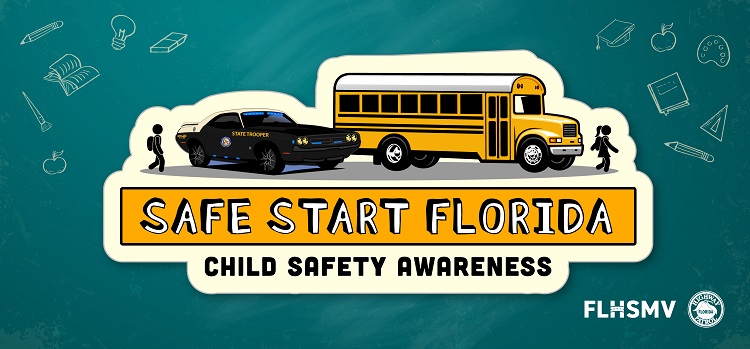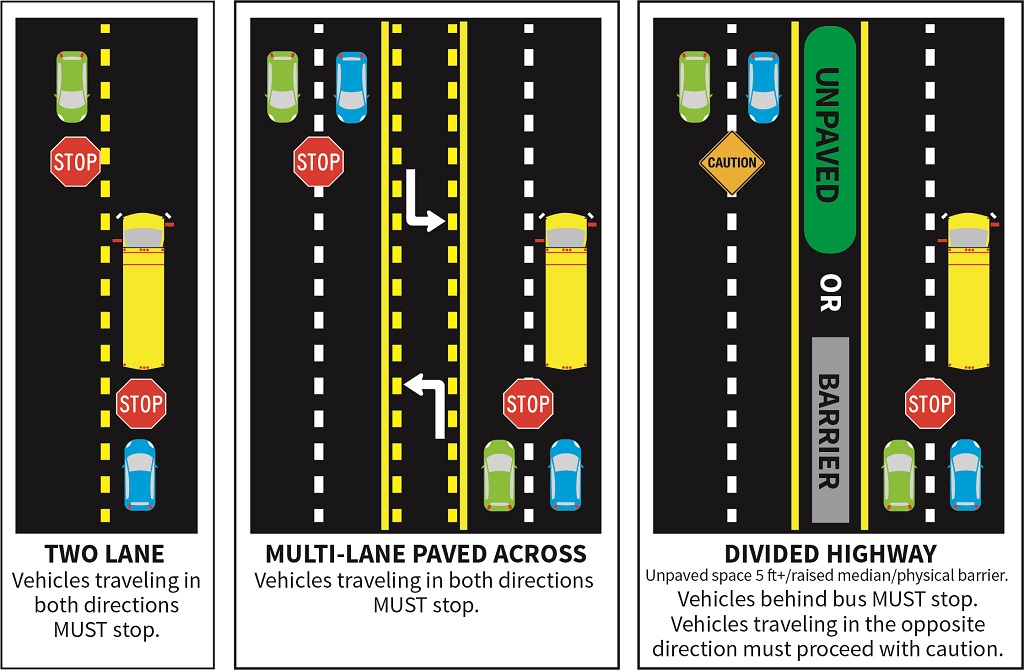Child Safety
School Bus Safety

For more resources, visit the main Child Safety web page.
As of January 1, 2021, the penalties for failing to stop for a school bus and passing a stopped school bus on the side where children enter and exit doubled. It is imperative that all motorists properly stop for school buses so all of Florida’s children can arrive at school or home safely.
Using a wireless communications device in a handheld manner while driving in a designated school crossing, school zone, or active work zone area is against the law and extremely dangerous.
Florida school buses carry precious cargo – our children. Motorists should always be alert and drive with caution around school buses and in school zones where children may be present like schools, bus stops, school buses and school parking lots. Parents should also go over safety tips with their children to make sure they are safe on and around school buses and school zones.
Pay extra attention to the lower speed limits in school zones – and obey them!
Watch for and obey signals from school crossing guards.
Only drive or park in authorized areas to drop off or pick up children at school.
At bus stops, children should wait in a safe place away from the road. Never sit on the roadway or curb while waiting for your bus.
In 2022, there were almost 3,000 crashes involving school buses. Florida school buses carry precious cargo – our children. Prevent crashes by remaining alert and driving with caution around school buses and in school zones where children may be present such as schools, bus stops, school buses and school parking lots.
Parents are encouraged to review safety tips with their children to make sure they are safe on and around school buses and school zones.
Motorists are required to stop when approaching a school bus that is stopped with its red lights flashing and STOP arms extended. (See the different situations in the diagram below)

- All drivers moving in either direction on a two-way street must stop for a school bus displaying a stop signal, and must remain stopped until the road is clear of children AND the school bus stop arm is withdrawn. (see diagram, TWO-LANE)
- On a highway divided by a paved median, all drivers moving in either direction must stop for a school bus displaying a stop signal, and must remain stopped until the road is clear of children AND the school bus stop arm is withdrawn. (see diagram, MULTI-LANE)
- The only time traffic approaching an oncoming school bus does not need to stop, is if there is a raised barrier such as a concrete divider or at least five feet of unpaved space separating the lanes of traffic. (see diagram, DIVIDED HIGHWAY)
- On a highway divided by a raised barrier or an unpaved median at least 5 feet wide, drivers moving in the opposite direction do not have to stop for the bus (painted lines or pavement markings are not considered barriers). However, these motorists should slow down and watch for students loading or unloading from the bus. (see diagram, DIVIDED HIGHWAY)
Penalties for passing stopped school bus include:
- Moving violation subject to citation;
- Requirement to complete a basic Driver Improvement Course upon conviction;
- Four points on your driver license; and
- Minimum fine of $265, if you pass on the side where children enter and exit, you will receive a minimum fine of $465.
On July 1, 2017, the Cameron Mayhew Act took effect in Florida, which increases the minimum penalty for drivers who illegally pass a stopped school bus, resulting in the injury or death of another person. Cameron Mayhew was killed by a motorist that failed to stop as he was walking to his stopped school bus in 2016.
Penalties for passing a stopped school bus that causes or results in the serious bodily injury or the death of another person include:
- Serving 120 community service hours in a trauma center or hospital;
- Participating in a victim’s impact panel session, or if such a panel does not exist, attending a FLHSMV approved driver improvement course;
- Six points on your driver license;
- Suspension of license for a minimum of one year; and
- $1,500 fine.
School Bus Safety Tips for Parents and Children
- Arrive at the bus stop with about five minutes before the bus is scheduled to arrive.
- At bus stops, children should wait in a safe place away from the road. Never sit on the roadway or curb while waiting for your bus.
- Make sure your children know their bus driver’s name and bus number.
- Tell children to never speak to strangers at the bus stop or get into the car with a stranger. Children should tell parents, the bus driver and a teacher at school if a stranger tries to talk to them or pick them up.
- Children should never walk behind a bus and should stay away from bus wheels at all times. When the bus stops, children should wait for the driver’s signal that it is safe to cross the road or board the bus.
- Children should look both ways before crossing the street- look left, right and left again. Tell them to make eye contact to make sure the bus driver can see them as they cross the street.
- On the bus, children should remain seated at all times and keep the aisle clear. Tell children not to put their head, hands or arms out the window.
- Remind children to stop talking and remain silent when the bus comes to a railroad crossing so the driver can hear if a train is approaching.
- Children should avoid any loud or disruptive behavior that could distract the bus driver from safely operating the bus.
- Refer to the official Florida Driver License Handbook for more information on school bus safety.
Resources
Florida Department of Education – School Transportation Information

Dave Kerner, Executive Director